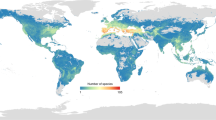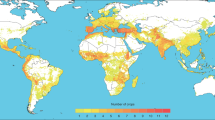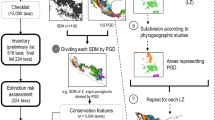Abstract
The wild relatives of domesticated crops possess genetic diversity useful for developing more productive, nutritious and resilient crop varieties. However, their conservation status and availability for utilization are a concern, and have not been quantified globally. Here, we model the global distribution of 1,076 taxa related to 81 crops, using occurrence information collected from biodiversity, herbarium and gene bank databases. We compare the potential geographic and ecological diversity encompassed in these distributions with that currently accessible in gene banks, as a means to estimate the comprehensiveness of the conservation of genetic diversity. Our results indicate that the diversity of crop wild relatives is poorly represented in gene banks. For 313 (29.1% of total) taxa associated with 63 crops, no germplasm accessions exist, and a further 257 (23.9%) are represented by fewer than ten accessions. Over 70% of taxa are identified as high priority for further collecting in order to improve their representation in gene banks, and over 95% are insufficiently represented in regard to the full range of geographic and ecological variation in their native distributions. The most critical collecting gaps occur in the Mediterranean and the Near East, western and southern Europe, Southeast and East Asia, and South America. We conclude that a systematic effort is needed to improve the conservation and availability of crop wild relatives for use in plant breeding.
This is a preview of subscription content, access via your institution
Access options
Subscribe to this journal
Receive 12 digital issues and online access to articles
$119.00 per year
only $9.92 per issue
Buy this article
- Purchase on Springer Link
- Instant access to full article PDF
Prices may be subject to local taxes which are calculated during checkout




Similar content being viewed by others
References
Tilman, D. & Clark, M. Global diets link environmental sustainability and human health. Nature 515, 518–522 (2014).
Khoury, C. K. et al. Increasing homogeneity in global food supplies and the implications for food security. Proc. Natl Acad. Sci. USA 111, 4001–4006 (2014).
Foley, J. A. et al. Solutions for a cultivated planet. Nature 478, 337–342 (2011).
Godfray, H. C. J. et al. Food security: the challenge of feeding 9 billion people. Science 327, 812–818 (2010).
Tilman, D., Balzer, C., Hill, J. & Befort, B. L. Global food demand and the sustainable intensification of agriculture. Proc. Natl Acad. Sci. USA 108, 20260–20264 (2011).
Ray, D. K., Mueller, N. D., West, P. C. & Foley, J. A. Yield trends are insufficient to double global crop production by 2050. PLoS One 8, e66428 (2013).
Cordell, D., Drangert, J.-O. & White, S. The story of phosphorus: global food security and food for thought. Global Environ. Change 19, 292–305 (2009).
Asseng, S. et al. Rising temperatures reduce global wheat production. Nature Clim. Change 5, 143–147 (2015).
Zhu, Y. et al. Genetic diversity and disease control in rice. Nature 406, 718–722 (2000).
McCouch, S. et al. Feeding the future. Nature 499, 23–24 (2013).
Esquinas-Alcázar, J. Protecting crop genetic diversity for food security: political, ethical and technical challenges. Nature Rev. Genet. 6, 946–953 (2005).
Hajjar, R. & Hodgkin, T. The use of wild relatives in crop improvement: a survey of developments over the last 20 years. Euphytica 156, 1–13 (2007).
Xiao, J., Grandillo, S., Ahn, S. N., McCouch, S. R. & Tanksley, S. D. Genes from wild rice improve yield. Nature 384, 356–358 (1996).
Gur, A. & Zamir, D. Unused natural variation can lift yield barriers in plant breeding. PLoS Biol. 2, e245 (2004).
McCouch, S. R. et al. Through the genetic bottleneck: O. rufipogon as a source of trait-enhancing alleles for O. sativa. Euphytica 154, 317–339 (2007).
Tanksley, S. D. & McCouch, S. R. Seed banks and molecular maps: unlocking genetic potential from the wild. Science 277, 1063–1066 (1997).
Guarino, L. & Lobell, D. B. A walk on the wild side. Nature Clim. Change 1, 374–375 (2011).
McCouch, S. R., McNally, K. L., Wang, W. & Hamilton, R. S. Genomics of gene banks: a case study in rice. Am. J. Bot. 99, 407–423 (2012).
Vincent, H. et al. A prioritized crop wild relative inventory to help underpin global food security. Biol. Conserv. 167, 265–275 (2013).
Food and Agriculture Organization of the United Nations (FAO) The Second Report on the State of the World‘s Plant Genetic Resources for Food and Agriculture (Commission on Genetic Resources for Food and Agriculture, FAO, 2010).
Jarvis, A., Lane, A. & Hijmans, R. J. The effect of climate change on crop wild relatives. Agric. Ecosyst. Environ. 126, 13–23 (2008).
Wilkes, G. Urgent notice to all maize researchers: disappearance and extinction of the last wild Teosinte population is more than half completed. A modest proposal for Teosinte evolution and conservation in situ: the Balsas, Guerrero, Mexico. Maydica 52, 49–58 (2007).
Brummitt, N. A. et al. Green plants in the red: a baseline global assessment for the IUCN sampled Red List Index for plants. PLoS One 10, e0135152 (2015).
Dempewolf, H. et al. Adapting agriculture to climate change: a global initiative to collect, conserve, and use crop wild relatives. Agroecol. Sustain. Food Syst. 38, 369–377 (2013).
Ramírez-Villegas, J., Khoury, C., Jarvis, A., Debouck, D. G. & Guarino, L. A gap analysis methodology for collecting crop gene pools: a case study with Phaseolus beans. PLoS One 5, e13497 (2010).
Vavilov, N. I. Centers of origin of cultivated plants. Bull. Appl. Bot. Plant Breed. 16, (1926).
Myers, N., Mittermeier, R. A., Mittermeier, C. G., da Fonseca, G. A. B. & Kent, J. Biodiversity hotspots for conservation priorities. Nature 403, 853–858 (2000).
Secretariat of the Convention on Biological Diversity (CBD). Decision X/2. The Strategic Plan for Biodiversity 2011-2020 and the Aichi Biodiversity Targets (2010).
Food and Agriculture Organization of the United Nations (FAO). International Treaty on Plant Genetic Resources for Food and Agriculture (2009).
Secretariat of the Convention on Biological Diversity (CBD). Nagoya Protocol on Access to Genetic Resources and the Fair and Equitable Sharing of Benefits Arising from their Utilization to the Convention on Biological Diversity (2011).
Wiersema, J. H., León, B. & Garvey, E. J. in ISHS Acta Horticulturae 948 I International Symposium Wild Relatives of Subtropical Temperate Fruit and Nut Crops (eds Aradhya, M. K. & Kluepfel, D. A. ) 285–288 (ISHS, 2012).
Eckert, C. G., Samis, K. E. & Lougheed, S. C. Genetic variation across species’ geographical ranges: the central-marginal hypothesis and beyond. Mol. Ecol. 17, 1170–1188 (2008).
Goodwin, Z. A., Harris, D. J., Filer, D., Wood, J. R. I. & Scotland, R. W. Widespread mistaken identity in tropical plant collections. Curr. Biol. 25, R1066–R1067 (2015).
Acknowledgements
We thank J. Wiersema and B. León for major contributions to taxonomic concepts; the herbaria, gene banks, researchers and other sources that contributed occurrence data to the analysis (Supplementary Table 3); the expert evaluators of gap analysis results (Supplementary Table 4); S. Calderón, I. Vanegas, H. Tobón, D. Arango, H. Dorado and E. Guevara for data inputs and processing; and S. Prager for comments. This work was undertaken as part of the project ‘Adapting Agriculture to Climate Change: Collecting, Protecting and Preparing Crop Wild Relatives’, which is supported by the Government of Norway. The project is managed by the Global Crop Diversity Trust and the Millennium Seed Bank of the Royal Botanic Gardens, Kew, and implemented in partnership with national and international gene banks and plant breeding institutes around the world. For further information, visit the project website: http://www.cwrdiversity.org/. Funding was also provided by the CGIAR Research Program on Climate Change, Agriculture, and Food Security, Cali, Colombia.
Author information
Authors and Affiliations
Contributions
N.P.C.-A., C.K.K., H.D., R.J.E., L.G., A.J., N.M., J.M., J.R-V. and J.T. conceived and designed the study. N.P.C.-A., C.K.K., H.D., R.J.E., R.H.H., A.J., N.M., J.R-V., C.C.S. and H.V. acquired and contributed data. N.P.C.-A., C.K.K., H.A.A., V.B. and C.C.S. processed the data, performed the analyses and analysed the results. N.P.C.-A., C.K.K., H.D., R.J.E., L.G., A.J., N.M. and J.M. interpreted the results and wrote the manuscript. N.P.C.-A., C.K.K., V.B., H.D., R.J.E., L.G., A.J., N.M., J.M., J.R-V. and P.C.S. edited the manuscript.
Corresponding author
Ethics declarations
Competing interests
The authors declare no competing financial interests.
Supplementary information
Rights and permissions
About this article
Cite this article
Castañeda-Álvarez, N., Khoury, C., Achicanoy, H. et al. Global conservation priorities for crop wild relatives. Nature Plants 2, 16022 (2016). https://doi.org/10.1038/nplants.2016.22
Received:
Accepted:
Published:
DOI: https://doi.org/10.1038/nplants.2016.22
This article is cited by
-
Genomics empowering conservation action and improvement of celery in the face of climate change
Planta (2024)
-
Investigation of genetic diversity of Iranian wild relatives of bread wheat using ISSR and SSR markers
Journal of Genetic Engineering and Biotechnology (2023)
-
Flourish with the wild
Nature Plants (2023)
-
Genebanking plant genetic resources in the postgenomic era
Agriculture and Human Values (2023)
-
Conserving useful plants for a sustainable future: species coverage, spatial distribution, and conservation status within the Millennium Seed Bank collection
Biodiversity and Conservation (2023)



